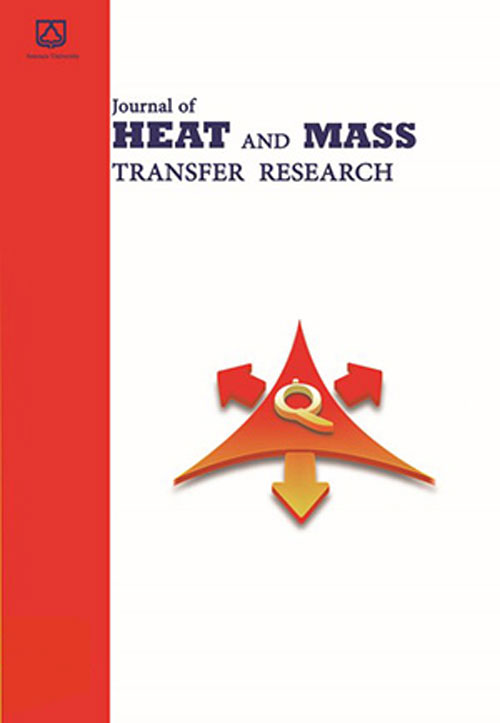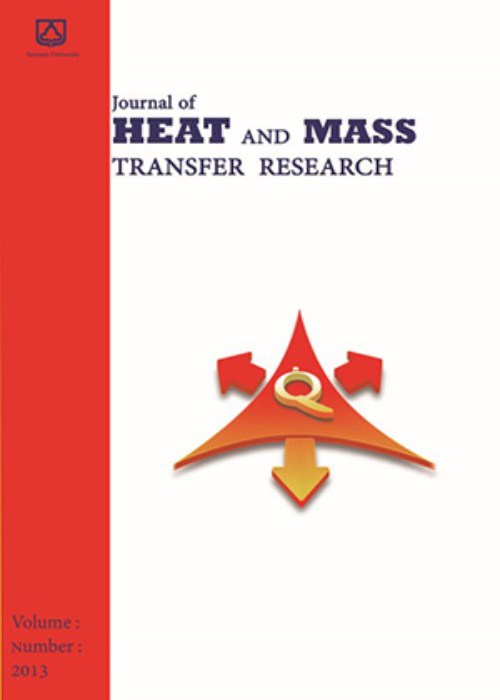فهرست مطالب

Journal of Heat and Mass Transfer Research
Volume:2 Issue: 2, Summer-Autumn 2015
- تاریخ انتشار: 1395/04/10
- تعداد عناوین: 8
-
-
Page 1Buoyancy driven heat transfer of Cu-water nanofluid in a differentially heated square cavity with an inner adiabatic square baffle at different positions is studied numerically. The left and right walls of the cavity are at temperatures of Th and Tc, respectively that Th > Tc, while the horizontal walls are insulated. The governing equations are discretized using the finite volume method while the SIMPLER algorithm is used to couple velocity and pressure fields. A parametric study is conducted and effects of Rayleigh number (103 to 106), the position of the baffle (six different positions), and the volume fraction of nanoparticles (0 to 0.1) on flow pattern, temperature distribution and heat transfer inside the cavity are investigated. The obtained results show that the rate of heat transfer is enhanced with increase of both Rayleigh number and volume fraction of nanoparticles. Moreover it is found that based on the Rayleigh number, the effect of position of the baffle on the rate of heat transfer varies. At all Rayleigh number considered, when the baffle is located in the core of the cavity, maximum rate of heat transfer occurs. Also the position of the baffle has a minimum effect on the rate of heat transfer at Ra = 106.Keywords: Natural Convection, Nanofluids, Cavity, Adiabatic Body, Numerical Study
-
Page 15In the present study, the operating conditions of an anode-supported high temperature direct internal reforming (DIR) planar solid oxide fuel cell (SOFC) are numerically analyzed. SOFCs are the energy conversion devices that produce electricity and heat directly from a gaseous fuel by the electrochemical combination of that fuel with an oxidant. A planar SOFC consists of an interconnect structure and a three-layer region often referred to as the PEN (Positive electrode/Electrolyte/Negative electrode) composed of two ceramic electrodes, anode and cathode, separated by a dense ceramic electrolyte. A 1D mathematical model based on the species and the energy balances is conducted to investigate the concentration of the gas components in the channels and the cell temperature distribution in both solid structures and gas channels. In addition, the electrochemical model of the cell is applied to determine its performance parameters. A synthesis gas with 10% pre-reformed methane as fuel stream is fed to the cell and the water-gas shift, the methane-steam reforming and the electrochemical reactions are considered as mass and heat sources/sinks. The effects of the air ratio and the fuel utilization factor on the temperature field and the performance of the cell are examined through parametric analysis to determine the optimum operating conditions of the cell. The investigations are performed to ensure no cracking will occur due to cell crucial temperature difference. The results indicate that increasing the fuel utilization factor from 0.45 to 0.85 leads to increase the value of the maximum temperature difference across the PEN layer from 101K to 145K while it decreases from 177K to 124K by increasing the air ratio from 6.5 to 12.5. In order to achieve the maximum power density by considering the maximum allowable temperature difference across the cell, the value of the fuel utilization factor and the air ratio are obtained 0.85 and 9, respectively.Keywords: Numerical analysis, Fuel cell, SOFC, DIR, PSOFC
-
Page 27In recent years, the feasibility of utilizing gas hydrates in industrial systems draws much attention as a subject of engineering studies. Despite the suggested applications for gas hydrate in transportation and storage of natural gas, desalination of water, etc., there have been few applied industrial experiences with gas hydrates. There are several patents and papers on promotion of gas hydrate formation thermodynamics and kinetics , but apparatuses and processes are rarely discussed. In designing a process based on gas hydrate for industrial application, one must include the following operations: formation, separation, pelletizing, storage, transportation and re-gasification. In this review article, different operations considering applications of gas hydrate are fully discussed. These operations are classified based on both contact of liquid and vapour phases and methods of conducting mass and heat transfer.Keywords: Gas hydrate, Hydrate formation, Natural gas transportation, Hydrate pelletizing, Hydrate regasification
-
Page 37In the present research, free convection heat transfer from isothermal concave and convex body shapes is studied numerically. The body shapes investigated here, are bi-sphere, cylinder, prolate and cylinder with hemispherical ends; besides, they have the same height over width (H/D = 2). A Numerical simulation is implemented to obtain heat transfer and fluid flow from all of the geometries in a wide range of Rayleigh numbers. The results show that flatness, concavity and smoothness have major effects on estimation of free convection heat transfer. As the total surface heat transfer area changed by altering the geometry, the local Nusselt number are compared for these body shapes; as well; it shows that concave surfaces has adverse influence on transferring heat. In addition, the current results reveal the average Nusselt numbers based on square surface area are not affected by the geometries for the laminar range of Rayleigh numbers. Besides, incompressible ideal gas model is used for the variation of density in free convection heat transfer. This model has the capability to be utilized in the cases with high temperature differences between the fluid and the bodies surfaces.Keywords: Free Convection, Concave surface, Convex surface, Numerical simulation
-
Page 45In the present study, an experimental study is carried out to investigate the effect of adding Al and Cu nanoparticles to the base fluid (water) on the heat transfer rate in a spirally coiled tube. The spirally coiled tube is fabricated from the straight copper tube with the inner and outer coil diameters of 100 and 420 mm, respectively. The experiments have been done for water and two types of nanofluids with different concentrations and at various operational conditions. The Thermal conductivities of these fluids have been measured experimentally. The results show that thermal conductivity of Cu-water nanofluid is about 18 % more than Al-water nanofluid at 2.23 vol. %. The forced convective heat transfer has been studied by changing the wall temperature, concentration, Gz number, and nanofluid type. The Results indicate that nanofluids have significant positive effect on convective heat transfer coefficient. Also, the Nusselt number increases with an increase in the Gz number. The most important effective parameters on the heat transfer are found to be the Gz number based on the analysis of variance (ANOVA) method. Based on the statistical analysis, a new correlation for the Nusselt number is introduced.Keywords: Nanofluids, Spiral coil, ANOVA, Nu number, Thermal conductivity
-
Page 51The entropy generation during hydromagnetic boundary layer flow of a viscous incompressible electrically conducting fluid due to radial stretching sheet with Newtonian heating in the presence of a transverse magnetic field and the thermal radiation has been analyzed. The governing equations are then solved numerically by using the fourth order Runge-Kutta method with shooting technique. The effects of the pertinent parameters on the fluid velocity, temperature, entropy generation number, Bejan number, as well as the shear stress at the surface of the sheet are discussed graphically and quantitatively. It is examined that because the presence of a magnetic field, the entropy generation in a thermal system can be controlled and reduced.Keywords: Hydromagnetic flow, Newtonian heating, Entropy generation, radially stretching sheet
-
Page 63The motion of temperature dependent viscosity and thermal conductivity of steady incompressible laminar free convective (MHD) non-Newtonian Casson fluid flow over an exponentially stretching surface embedded in a thermally stratified medium are investigated. It is assumed that natural convection is induced by buoyancy and exponentially decaying internal heat generation across the space. The dimensionless temperature is constructed such that the effect of stratification can be revealed. Similarity transformations were employed to convert the governing partial differential equations to a system of nonlinear ordinary differential equations. The numerical solutions were obtained using shooting method along with the Runge-Kutta Gill method. The behaviour of dimensionless velocity, temperature and temperature gradient within the boundary layer has been studied using different values of all the controlling parameters. The numerical result show that increase in the magnitude of temperature dependent fluid viscosity parameter leads to an increase in velocity, decrease in temperature, decrease in temperature gradient near the wall and increase in temperature gradient far from the wall. The velocity profile increases, temperature distribution increases and temperature gradient increases near the wall only by increasing the magnitude of temperature dependent thermal conductivity parameter.Keywords: Casson fluid, Variable viscosity, Variable thermal conductivity, Space dependent heat source, Thermal stratification
-
Page 79This research deals with heat and mass transfer in biscuit industrial baking ovens. In these ovens, heat reaches biscuits indirectly by radiation, convection and conduction. The method for numerical solution is that we first provide the related equations, then they are discretized by finite difference method (FDM), and finally, after encoding and writing a program for the computer, we run it. The Obtained results indicate that biscuit heat absorption occurs 69 % through radiation, 28% convection and 3 % conduction. This percent of conduction depends on the type of band conveyor. Baking time depends on temperature of the baking chamber. For example, it takes 7 minutes for biscuits to reach 4% of moisture in 2000C.By increasing temperature of the baking chamber, the cooking time is decreased. Based on obtained results, there is a balance between heat and mass transfer rate. Results obtained from solving the equations indicates that maximum temperature of biscuits reaches 1500C and the highest moisture of baking chamber is almost at the middle of the oven. Vapors generated by this procedure are sent out by several fans, installed inside the baking chamber at the same distance. Simulated data of heat and mass transfer equations are in good agreement with experimental results. Obtained results can be used to control baking time and to production good quality for biscuits.Keywords: Heat, mass transfer, Oven, Baking Biscuit, Industrial


